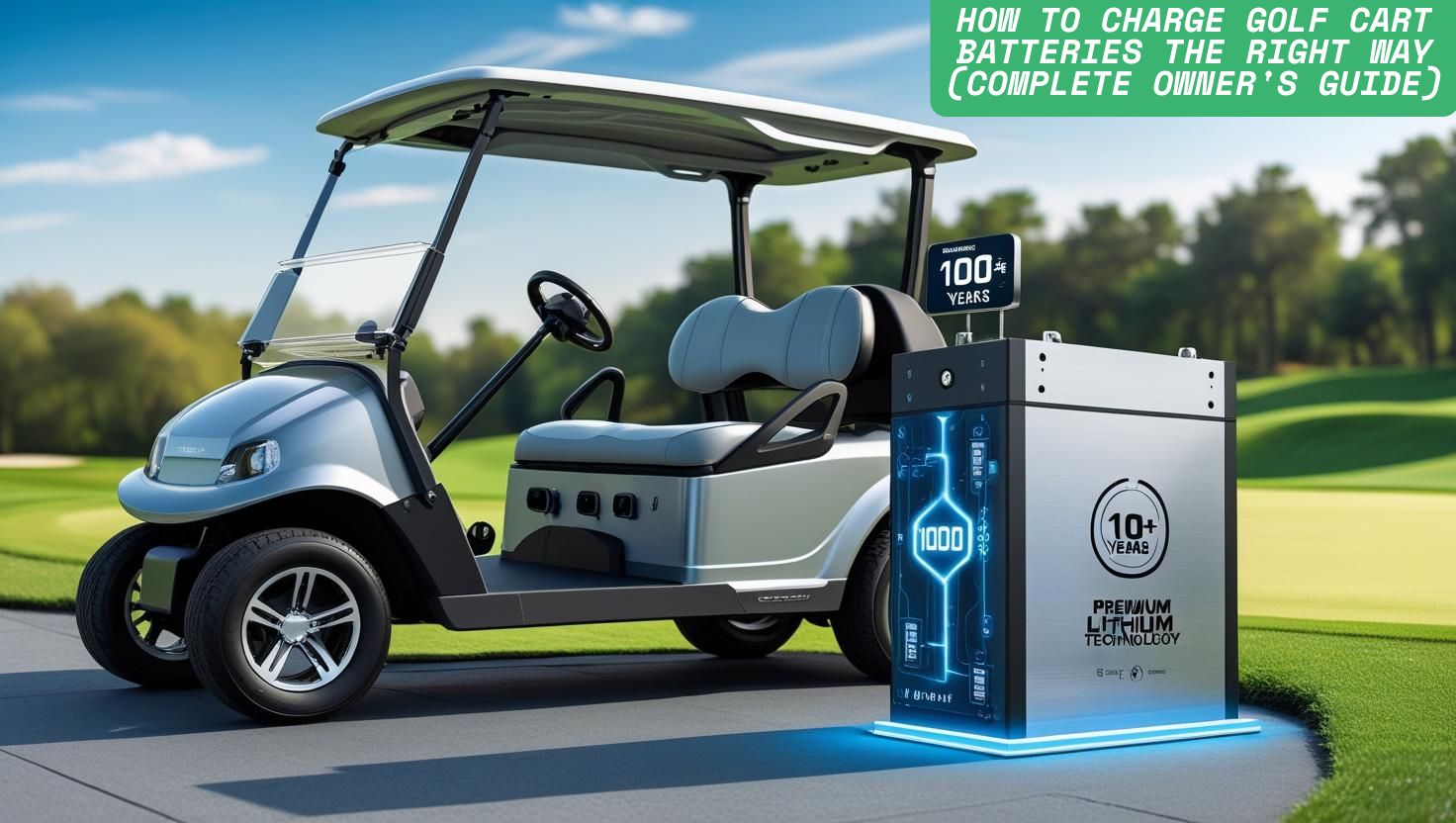Golf cart batteries are the heart of your electric vehicle, and proper charging isn’t just about plugging in and walking away. Whether you’re a weekend golfer, fleet manager, or use your cart for neighborhood transportation, understanding the nuances of battery charging can mean the difference between batteries that last 2 years versus 8 years.
Understanding Your Golf Cart Battery System
Most golf carts use deep-cycle batteries in configurations of 36V (six 6-volt batteries) or 48V batteries (six 8-volt or eight 6-volt batteries). Unlike car batteries designed for quick bursts of power, these deep-cycle batteries are engineered for sustained energy delivery over longer periods.
The Battery Chemistry Breakdown:
- Lead-Acid (Flooded): Most common, requires water maintenance, typically 4-6 year lifespan
- AGM (Absorbed Glass Mat): Maintenance-free, better vibration resistance, 5-7 year lifespan
- Lithium: Premium option, 10+ year lifespan, lighter weight, faster charging
Step-by-Step Charging Process
Pre-Charging Inspection (Often Overlooked)
Before plugging in, spend 30 seconds checking these critical points:
- Clean the battery tops – Dirt and corrosion create phantom electrical draws
- Check water levels (flooded batteries only) – Add distilled water if plates are exposed
- Inspect cable connections – Loose connections cause uneven charging and premature failure
- Verify charger settings – Wrong voltage settings can destroy batteries in a single charge cycle
The Charging Steps
Step 1: Position and Ventilation Park your cart in a well-ventilated area, preferably on level ground. Charging produces hydrogen gas, which is explosive in enclosed spaces. Pro tip: A small fan can dramatically improve ventilation in tight spaces.
Step 2: Connect the Charger
- Plug the charger into the cart FIRST, then into the wall outlet
- This sequence prevents dangerous arcing and extends charger life
- Ensure the connection is fully seated – partial connections cause overheating
Step 3: Monitor Initial Startup Your charger should begin its cycle immediately. If it doesn’t start within 30 seconds, check connections and battery voltage. A completely dead battery bank may need manual intervention.
Step 4: Let Technology Work Modern smart chargers handle the complex charging phases automatically:
- Bulk Phase: 80% charge at maximum amperage
- Absorption Phase: Voltage held constant while amperage decreases
- Float Phase: Maintains full charge without overcharging
Step 5: Proper Disconnection Unplug from the wall FIRST, then disconnect from the cart. This prevents the common mistake of creating sparks while disconnecting under load.
Unique Charging Insights Most Guides Miss
The Temperature Factor
Battery charging efficiency drops dramatically in cold weather. A battery that charges in 8 hours at 70°F may take 12+ hours at 32°F. Consider this when planning winter storage or early morning rounds.
The 80/20 Rule
Batteries last longest when kept between 20% and 80% charge for daily use. Only charge to 100% before extended storage or long-distance trips. This simple practice can double battery lifespan.
Water After, Not Before
Always add water to flooded batteries AFTER charging, never before. Charging causes the electrolyte to expand, and overfilling can cause dangerous spillage.
The Equalization Secret
Monthly equalization charges (slightly overcharging in a controlled manner) prevent sulfation and balance individual cell voltages. Most smart chargers have this feature – use it.
Advanced Charging Strategies
For Fleet Managers
Implement a rotation system where carts charge for exactly 8-10 hours, not 24/7. Constant float charging actually shortens battery life despite seeming protective.
For Seasonal Users
Before winter storage, charge batteries to 100%, then disconnect them completely. Check and top-charge monthly during storage. A battery maintainer isn’t always better than periodic charging.
For Daily Commuters
Avoid the “convenience charge” trap. Don’t top off batteries after short trips. Instead, charge when the voltage drops to about 50% capacity or after every 2-3 short uses.
Common Charging Mistakes That Kill Batteries
The Overcharging Trap: Leaving carts plugged in for days isn’t protective – it’s destructive. Even smart chargers can overcharge if left connected too long.
Mixed Battery Syndrome: Never mix old and new batteries, or different brands/types. The charging system can’t accommodate different internal resistances.
The Quick-Charge Fallacy: While lithium batteries can handle fast charging, lead-acid batteries need slow, steady charging for longevity. Resist the urge to use automotive chargers for “quick” charges.
Troubleshooting Charging Issues
Charger Won’t Start
- Check battery voltage with multimeter (should be above 30V for 36V system, 40V for 48V system)
- Clean all connections with wire brush
- Verify charger fuse isn’t blown
Incomplete Charging
- Individual cell failure (voltage test each battery)
- Sulfation from prolonged undercharging
- Charger calibration drift (professional testing needed)
Excessive Charging Time
- Temperature compensation issue
- Internal resistance increase (battery aging)
- Charger amperage decline
Maximizing Battery Investment
The difference between a $1,200 battery set lasting 3 years versus 7 years often comes down to charging habits. Consider these ROI factors:
- Proper charging saves approximately $400-600 per year in premature replacement costs
- Well-maintained batteries hold resale value better
- Consistent performance eliminates mid-round failures and towing costs
Seasonal Considerations
Summer Charging: Hot weather accelerates chemical reactions. Charge during cooler parts of the day when possible, and ensure adequate ventilation.
Winter Preparation: Cold batteries accept charge poorly. Store in heated areas when possible, or use battery blankets in unheated storage.
Spring Startup: After winter storage, perform an equalization charge before first use. Check specific gravity if you have a hydrometer.
Final Thoughts
Charging golf cart batteries correctly isn’t complicated, but it does require consistency and attention to detail. The habits you develop in your first month of ownership will largely determine whether you’re shopping for new batteries in year 3 or year 8.
Remember: batteries are consumable components, but proper charging practices can make them very slow-consuming components. The 15 minutes you invest in proper charging procedure and monthly maintenance will save you hundreds of dollars and countless frustrations down the road.
Your golf cart batteries are an investment in freedom and mobility. Treat them with the respect they deserve, and they’ll provide years of reliable service, whether you’re chasing birdies or cruising the neighborhood.
